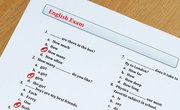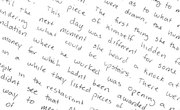Also known as present continuous tense, present progressive tense is used to denote action that is continuous. It can be used to refer to action that is happening right now. For example, "I am washing the dishes." It can be used to discuss action that happens over a period of time, such as "She is going to medical school." The present progressive tense can also be used to refer to actions that will happen in the future, such as "He is going to a concert next week."
Basic Structure
A present progressive verb is made up of two parts: a form of the present tense of the verb "to be" and the present participle of an action verb. An action verb is a verb that denotes action by the subject. The action can be physical or mental.
The Verb To Be
To form the progressive tense, use a form of the verb "to be." The form depends upon the subject of the sentence. First person singular: I am Second person singular: You are Third person singular: He is First person plural: We are Second person plural: You are
Third person plural: They are
Present Participle
A present participle is an action verb with "-ing" added to the end. For example, the present participle of the action verb "walk" would be "walking." Many verbs change spelling when "-ing" is added. For verbs made up of consonant-vowel-consonant format, double the consonant before adding "-ing," as in "hopping." For verbs that end in silent "e," drop the "e" before adding "-ing," as in "hiring." For verbs that end in the vowel digraph "ie," change the "ie" to "y" before adding "-ing," as in "tying." The present participle of a verb is the same, regardless of the subject.
Examples
First person singular: "I am walking." Second person singular: "You are walking." Third person singular: "She is walking." First person plural: "We are walking." Third person plural: "They are walking." Question: "Is she walking to work?"
Other Tenses Using the Present Participle
Tenses such as the past progressive, future progressive and present perfect progressive use the present participle, but the form of the verb "to be" is not in the present. An example the past progressive, "I was walking."
Related Articles
Writer Bio
Ashley Seehorn has been writing professionally since 2009. Her work has been featured on a variety of websites including: eHow, Answerbag and Opposing Views Cultures. She has been a teacher for 20 years and has taught all ages from preschool through college. She is currently working as a Special Education Teacher.










